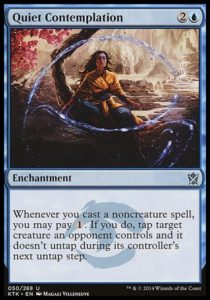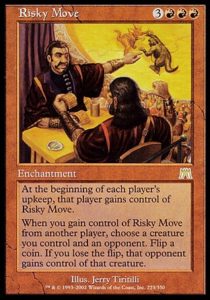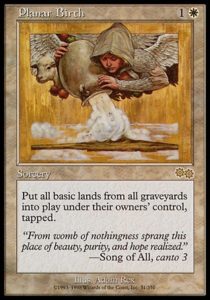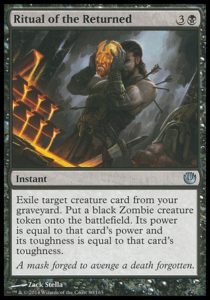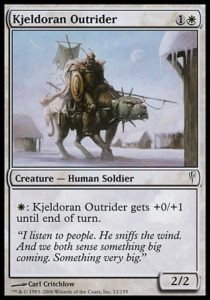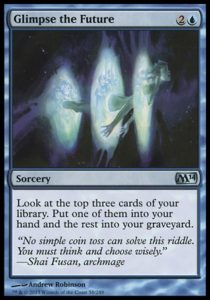The Eldritch Moon looms but remains weeks away. Kaladesh comes this fall. The spring set’s plane is completely unknown. This summer is different from every other.
Every summer since 2010 we’ve been gearing up for the newest core set and eagerly looking to the fall for the new plane we’d be spending a year on. Everything’s different, thanks to the two block paradigm. Now, we visit two planes a year, each getting two expansions, and have no core set. While Eldritch Moon isn’t here quite yet, its arrival heralds the end of the first year of two-set blocks. I’d like to take the opportunity to take stock of how far we’ve come so far and where we’ll be going.
Overall, the two block paradigm is awesome. Novelty is great and seeing twice as many worlds, set mechanics, and storylines is fantastic. Magic has worked much harder to integrate its story with its artwork and gameplay, leading to record high engagement with and understanding of the story. The shorter Standard rotation allows Wizards to take more risks and Magic has been forever changed by the addition of cards like Thought-Knot Seer and Nahiri, the Harbinger.
Standard has been generally lauded for being diverse, though there’ve been a couple seeming missteps in the past year: the fetchland-Battleland interaction (which lead to the most expensive Standard format ever and a lot of similar-feeling four color decks that played all the best cards), the lack of sufficient graveyard and token hate (to prevent the seeming dominance of Rally the Ancestors and GW tokens decks), and the color imbalance of the current Standard environment (where white and green seem to reign supreme). Nevertheless, the past year has featured a variety of unusual and high-performing decks featuring cards like Pyromancer’s Goggles, Sphinx’s Tutelage, and World Breaker. So, while Standard isn’t my preferred format (I’ve a Limited lover and Modern man), it certainly isn’t in terrible shape.
The biggest risk of the two block paradigm is the added burden for R&D. Even though the same amount of expansions are being released each year, the workload is dramatically increased. Creative needs to create twice as many worlds per year, as well as make sure that the story is adequately conveyed through cards and marketing. Design needs to churn through twice as many worlds, making them feel mechanically unique and play differently from what came before. Development needs to allow more to change every year while still ensuring that Limited and Standard remain fun and balanced.
There is a constant need to innovate in Magic, whether traveling to a new world or returning to an old one. However, if Wizards does nothing but venture into new territory, it risks quickly exhausting design space and making subsequent sets harder and harder to make. Mark Rosewater puts this excellently in last year’s State of Design, where he acknowledges that Dragons of Tarkir didn’t go perfectly:
Magic has a long history of creating cool, exciting worlds and then trashing them. I believe it is one of the biggest issues with a three-set block, that the need to make the last set so different mechanically pushes us to do radical things to the world to match the environmental shift.
Long ago, we saw mechanics as disposable; we then came to realize that they were valuable tools we could reuse. I think in many ways we used to see worlds in the same way. We visit and move on. But now we’re realizing we’ve built cool places we want to go back to. That gets us to this problem. We made a very compelling world that players fell in love with, and then we changed it to a less compelling world forever. Now, I don’t believe we thought we were doing that. We over-valued the Dragon-filled world and underestimated the warlord clan world.
Worlds are a finite and valuable resource that Wizards has often made difficult, if not impossible to return. Last year, I checked in with every plane seen since 2003 (when Magic stopped setting the majority of its sets on Dominaria) and how easy it would be to revisit them by block’s end. Let’s see how we’re doing now.
Planes in green were introduced as one thing and concluded their block as the same thing (or close enough). They are easy to return to.
Planes in red underwent a fundamental change by block’s end. They are difficult or impossible to return to.
Planes in orange kind of straddle the line. They underwent a major change, but at least some of their core concept remains.
- 2002: Dominaria, the jack-of-all-worlds, survived Onslaught block.
- 2003: Mirrodin started and ended its block as Artifact World.
- 2004: Kamigawa started and ended its block as Spirit World.
- 2005: Ravinca‘s guilds were destroyed.
- 2006: Time Spiral all but destroyed Dominaria.
- 2007: Lorwyn transformed into Shadowmoor. The Great Aurora was stopped, so the plane’s status is unclear.
- 2008: Alara, Shard World became shardless.
- 2009: Zendikar ended its block doomed by the Eldrazi.
- 2010: Mirrodin, was destroyed and remade into New Phyrexia.
- 2011: Innistrad endured, but much of its Gothic horror was seemingly ended by Avacyn’s return and the Cursemute eliminated werewolves, one of the defining features of the plane.
- 2012: Ravinca was returned to its original state.
- 2013: Theros started and ended its block as Greek Mythology World.
- 2014: Tarkir (Khans version) was erased from the timeline.
- 2015: Tarkir (Dragons version) is here to stay.
- 2015: Zendikar was saved, but the Zendikar featured was that of Rise of the Eldrazi, not the Adventure World people preferred. By block’s end, Adventure World is ready to return, but the BfZ Zendikar is gone along with the Eldrazi.
- 2016: Innistrad‘s fate is presently unknown. We’ll find out by next month whether Innistrad survives Emrakul’s arrival.
Let’s consider returns; we know that Wizards considers worlds valuable resources and in the two block paradigm, about 50% of all worlds will be returns. Consequently, Wizards has been working harder to make worlds, particularly popular worlds (which ideally, all worlds would be), able to revisited. So, let’s consider all returns over this period and see how well we’ve been doing on that front.
- Dominaria (2002)→ Dominaria (2007) [5 years apart]
- Mirrodin (2003)→ Mirrodin (2010) [7 years apart]
- Ravnica (2005)→ Ravnica (2012) [7 years apart]
- Zendikar (2009)→ Zendikar (2015) [6 years apart]
- Innistrad (2011)→ Innistrad (2016) [5 years apart]
While we’re dealing with a small sample size, we can still see a couple trends; the average return takes about 6 years and this number has decreased with time. While Dominaria and Mirrodin fared poorly when revisited, Ravnica and Zendikar were returned to their original, popular states by block’s end. This is evidence of Wizards working to preserve popular planes for return.
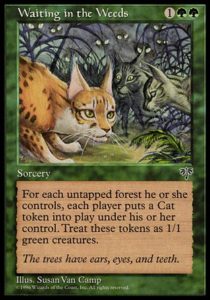 There remain a handful of planes not yet revisited. In the past 15 years, we’ve seen 15 different planes (setting aside Coldsnap, core sets, and supplemental sets). Of those, 6 were returns and 4 were new worlds that were later returned to. So, in the past 15 years, there are only five original planes we’ve not yet revisited. They are:
There remain a handful of planes not yet revisited. In the past 15 years, we’ve seen 15 different planes (setting aside Coldsnap, core sets, and supplemental sets). Of those, 6 were returns and 4 were new worlds that were later returned to. So, in the past 15 years, there are only five original planes we’ve not yet revisited. They are:
- Kamigawa (2004)
- Lorwyn (2006)
- Alara (2008)
- Theros (2013)
- Tarkir/Tarkir (2014)
Kamigawa and Lorwyn are relatively unpopular worlds and are unlikely to be settings for new expansions (though Lorwyn was featured in Magic Origins and Kamigawa was featured in Planechase 2012). Alara is of medium popularity and substantially different, so while it’s in the right time frame for a return, I wouldn’t be surprised if a return isn’t forthcoming.
Of all the worlds we’ve seen and not yet revisited, Theros is perhaps most likely for a return in a year or two. It’s popular, it’s intact, its has a significant dangling plotline (the fate of Elspeth) and it’s been three years. Sure, the median time for a return is six years, but that number has decreased with time and the two block paradigm may further accelerate that time frame, given that sets are coming out with double the frequency. Of the already-revisited worlds, I’d put money on second returns to at least one of (if not both) New Phyrexia and Ravnica by 2018; they’re incredibly popular planes and home to incredibly popular characters.
I acknowledge that the previous section, detailing revisited and un-revisited planes, is not comprehensive. There are plenty of worlds that Magic has created that could be either revisited, or featured for the first time in an expansion. These include, but are not limited to:
- Rabiah (1993)
- Ulgrotha (1995)
- Shandalar (books, various core sets, the awesome 1995 Microprose computer game)
- Fiora (featured in 2014’s Conspiracy and the upcoming Conspiracy II)
- Vryn (featured in 2015’s Magic Origins)
- Regatha (featured in 2015’s Magic Origins)
- Kaladesh (featured in 2015’s Magic Origins), which is the setting of the fall expansion.
- Various planes featured in Planechase
- Various planes referenced in Future Sight
Some of these planes are fairly unlikely (Rabiah isn’t an original Magic IP, it’s 1001 Arabian Nights; Ulgrotha is the setting for one of Magic’s least popular sets), while others, like Kaladesh, are certain to be visited at some point.
Overall, I’m optimistic about the future of planar design. Wizards is getting better at telling stories (which is awesome), and having those stories carry emotional weight and have ample conflict and characterization without also having them destroy fan-favorite planes. Not every plane will survive the experience, but this won’t always be a bad thing; while many of us lament the loss of the wedge-laden Tarkir, many of us are happy to have a New Phyrexia featuring Magic’s greatest villains.
Here’s looking forward to the future. And as always, thanks for reading.
—Zachary Barash
Zachary Barash has been playing Magic on and off since 1994. He loves Limited and drafts every available format (including several that aren’t entirely meant to be drafted). He’s a proud Cube owner, improviser, and game designer (currently going for an MFA in Game Design at NYU). He has an obsession with Indian food that borders on being unhealthy.

